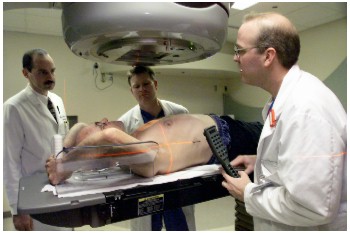
Dr. Dennis Hallahan (left) and radiation therapy technicians Ben Welch and Doug Satterfield prepare patient Carl Rudolph for therapy. (photo by Dana Johnson)
New technology hones radiation therapy's precision
Radiation oncologists at the Vanderbilt-Ingram Cancer Center can now more precisely sculpt radiation beams to the shape and depth of tumors, allowing them to deliver more cancer-killing energy to malignant areas while protecting adjacent healthy tissue.
In mid-December, VICC radiation oncologists began treating their first patients with the very latest in radiation therapy technology, called Intensity Modulated Radiation Therapy (IMRT). IMRT uses computer-generated images to plan and then deliver more tightly focused radiation beams than is possible with conventional therapy.
A key component of the complex system is the "multi-leaf collimator," a series of 80 metal fingers or leaves, about a quarter of an inch wide. These leaves are individually controlled by a computer to move in and out of the field for specific periods of time, effectively filtering the beams of radiation in a precise pattern.
"The goal is to push the dose higher to the tumor so we can more effectively treat the cancer," said Dr. Dennis Hallahan, professor and chair of Radiation Oncology at Vanderbilt. "This system allows us to intensify the dose because we are better able to segment into areas of tissue we don't want to treat at all, tissue you want to treat at an intermediate dosage and some tissues you want to treat at high doses."
Radiation therapy is a commonly used cancer therapy, whether alone or in combination with surgery and/or chemotherapy. The major challenge for radiation oncologists is to deliver the highest possible dose to the tumor while protecting the surrounding normal tissue, especially critical structures such as the heart, lungs or nerves. With more traditional systems, the target area must include some surrounding normal tissue to ensure that all of the tumor is included. That, in turn, limits the dose that can be delivered to the tumor.
In recent years, three-dimensional computerized imaging and planning systems have offered more precision in planning radiation treatment. However, traditional linear accelerators — the machine used to generate and deliver the beam of radiation to the tumor — have allowed shaping of the beam only in a two-dimensional fashion.
With traditional accelerators, specially made lead blocks are used to conform the X-ray beam to the shape of the tumor. Several blocks of different shapes may be used to treat a patient in order to tailor the dosage to the tumor during the total treatment, but while each block is in place, the dose of radiation is consistent all the way through the field. In order to shape the total dosage, the treatment must be periodically stopped to change the blocks.
The new equipment uses the multi-leaf collimator to shape the beam continuously throughout the procedure. The result is a varied dosage throughout the field, not only from side to side and top to bottom but also from front to back. In addition, as the machine rotates around the patient to deliver radiation from different angles, the leaves move to conform to the tumor dimensions from each new angle.
"With the old technology, we have to stop and switch the blocks, which takes time, but more than that, it is just not as precise as we would like to be," Hallahan said. "Ideally, we'd use an infinite number of blocks but that's just not feasible. With this equipment, we can essentially achieve that — treat a large number of subfields — in a matter of minutes."
A typical case in which IMRT might be most beneficial would be a brain tumor located near the eyes, optic nerve, pituitary and brain stem, Hallahan said.
The new $2 million system includes a new linear accelerator with the multi-leaf collimator and treatment planning software. The computer system takes diagnostic images from three different imaging technologies — CT, MRI and PET — and converts them to another computer system used to plan the treatment. In turn, that data is linked to a computer system that runs the accelerator.
The Vanderbilt-Ingram Cancer Center is the only center in the region with the capability to do IMRT, Hallahan said. Plans for Williamson County Medical Center and Vanderbilt to establish a radiation therapy center in Franklin next year include the same technology and connection between Vanderbilt and the Williamson County facility so that data could be shared. "Patients whose treatment is planned here could have their treatment there, and vice versa," Hallahan said.













